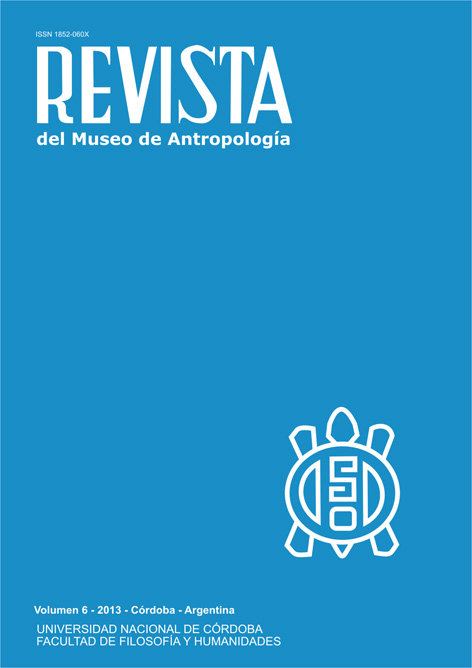The Hero’s Body: the Unveiling of the Bust of a Soldier Fallen in the Malvinas War
DOI:
https://doi.org/10.31048/1852.4826.v6.n1.5511Keywords:
performance, war, mourning, MalvinasAbstract
In this paper we will show how the unveiling of the bust of Elbio Araujo, a soldier fallen in the Malvinas War, expresses the symbolic framework for interpretation of death in battle of a particular group, at the same time becoming for his relatives the stage for dramatization of a death that could not be dealt with in the usual manner due to the lack of a body. We will deal with the ritual from the point of view of performance, since it allows us to see the ways experiences are lived in specific scenes, through which the death of a person is inhabited and signified in a particular way. Therefore, we will show that through the unveiling of the bust, the lack of the body is replaced by a different materiality and that the performance acts not only as a communication channel through which the bereaved express their experiences and the meanings given to death in war to society at large, but also becomes, for the families involved, a transformative practice through the proposed reflexivity on the social status of the deceased.Downloads
References
Álvarez, S. 2001. “Enterrando heróis, patriarcas, suicidas e traidores: solidariedade e ostracismo nos andes colombianos”. MANA, 7(2):35-55.
Ariès, P. 1999. El hombre ante la muerte. Grupo Santillana de Ediciones, Madrid.
Carozzi, M. 1998. El concepto de marco interpretativo en el estudio de movimientos religiosos. Sociedad y Religión 16/17:33-51.
Ferrer, E. 2003. El lenguaje de la inmortalidad. México. Fondo de Cultura Económica.
Grant, S. 2004. Patriot Graves: American National Identity and the Civil War Deae. American Nineteenth Century History, 5(3):74-100.
Goffman, E. 1974. Frame análisis: An essay on the organization of experience. New York. Harper Colophon Books.
Guber, R. 2001. ¿Por qué Malvinas? De la causa nacional a la guerra absurda. Fondo de Cultura Económica, Buenos Aires.
Guber, R. 2004. De chicos a veteranos. Memorias argentinas de la guerra de Malvinas. Antropofagia, Argentina.
Halbwachs, M. 2005. “Memoria individual y memoria colectiva”. Estudios 16:163-187.
Halbwachs, M. 2004. La memoria Colectiva. Traducción de Inés Sancho-Arroyo. Zaragoza, Prensas Universitarias de Zaragoza.
Jelin, E. 2002. Los trabajos de la memoria. Siglo XXI, Madrid.
Kohan, M. 2005. Narrar a San Martín. Adriana Hidalgo editora, Buenos Aires.
Le Goff J. 1991. El orden de la memoria. Paidós, Barcelona.
Lorenz, F. 2006. Las guerras por Malvinas. Editorial Edhasa, Buenos Aires.
Panizo, L. 2011a. Donde están nuestros muertos: experiencias rituales de familiares de desaparecidos de la última dictadura militar en la Argentina y caídos en la Guerra de Malvinas. Facultad de Filosofía y Letras. Universidad de Buenos Aires. Argentina. Tesis de doctorado. Facultad de Filosofia y Letras, UBA.
Panizo. L. 2009. Muerte, desaparición y memoria: el caso de los desaparecidos de la última dictadura militar en Argentina. Historia, Antropología y Fuentes Orales. 42: 71-84.
Panizo, L. 2011b. Cuerpo, velatorio y performance. Revista Tán@to’s. Sociedad Española e Internacional de Tanatología. 13:24-35
Pollak, M. 2006. Memoria, olvido, silencio. Ludmila da Silva Catela (comp.). Al Margen. La Plata.
Pitt-Rivers, J.1979. Antropología del Honor. Crítica, Barcelona
Stephens, J. 2007. Memory, Commemoration and the Meaning of a Suburban War Memorial. Journal of Material Culture, 12:241-261.
Turner, V. 1987. The Anthropology of Performance. PAJ Publications, New York
van Gennep, A. 2008. Los ritos de paso. Alianza Editorial, Madrid.
Verdery, K. 1999. The political lives of dead bodies: reburial and postcocialist change Columbia Universiyy Press, United States of America.
Downloads
Published
Issue
Section
License
Those authors who have publications with this Journalaccept the following terms:
a. Authors will retain their copyrights and guarantee the journal the right of first publication of their work, which will be simultaneously subject to the Creative Commons Attribution License (Licencia de reconocimiento de Creative Commons) that allows third parties to share the work as long as its author and his first publication in this journal.
b. Authors may adopt other non-exclusive licensing agreements for the distribution of the version of the published work (eg, deposit it in an institutional electronic file or publish it in a monographic volume) provided that the initial publication in this journal is indicated.
c. Authors are allowed and recommended to disseminate their work on the Internet (eg in institutional telematic archives or on their website) before and during the submission process, which can lead to interesting exchanges and increase citations of the published work. (See The Effect of Open Access - El efecto del acceso abierto)












